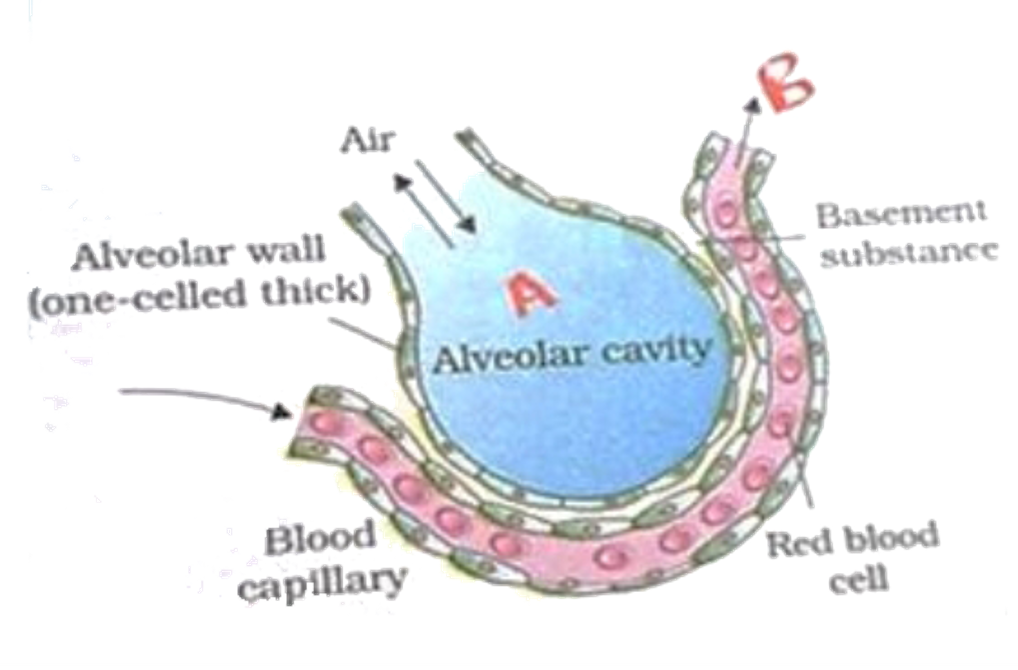The partial pressure of oxygen at ((A)) and blood capillary of lungs ((B)) will be :
A : 104 mm Hg , B : 95 mm Hg
A : 159 mm Hg , B : 95 mm Hg
A : 104 mm Hg , B : 40 mm Hg
A : 159 mm Hg , B : 95 mm Hg
The correct Answer is:A
To solve the question regarding the partial pressure of oxygen at point A (presumably the alveoli) and in the blood capillaries of the lungs, we can follow these steps:
1. Understanding Partial Pressure of Oxygen:
- The partial pressure of oxygen (pO2) refers to the pressure exerted by oxygen in a mixture of gases. It is a measure of how much oxygen is available to be utilized by the body.
2. Partial Pressure in the Alveoli (Point A):
- In the alveoli of the lungs, the partial pressure of oxygen is typically around 104 mm Hg. This is the pressure exerted by oxygen in the alveolar air, which is crucial for gas exchange.
3. Partial Pressure in Blood Capillaries (Point B):
- As blood flows through the pulmonary capillaries, it encounters a narrower space, which can affect the pressure. The partial pressure of oxygen in the blood capillaries of the lungs is approximately 95 mm Hg. This slight decrease occurs due to the dynamics of blood flow and gas exchange.
4. Conclusion:
- Therefore, the partial pressures of oxygen are:
- At point A (Alveoli): 104 mm Hg
- At point B (Blood capillaries of lungs): 95 mm Hg
Final Answer:
- The partial pressure of oxygen at point A is 104 mm Hg, and at point B (blood capillaries of lungs) is 95 mm Hg.
---
- The partial pressure of oxygen (pO2) refers to the pressure exerted by oxygen in a mixture of gases. It is a measure of how much oxygen is available to be utilized by the body.
- In the alveoli of the lungs, the partial pressure of oxygen is typically around 104 mm Hg. This is the pressure exerted by oxygen in the alveolar air, which is crucial for gas exchange.
- As blood flows through the pulmonary capillaries, it encounters a narrower space, which can affect the pressure. The partial pressure of oxygen in the blood capillaries of the lungs is approximately 95 mm Hg. This slight decrease occurs due to the dynamics of blood flow and gas exchange.
- Therefore, the partial pressures of oxygen are:
- At point A (Alveoli): 104 mm Hg
- At point B (Blood capillaries of lungs): 95 mm Hg
- The partial pressure of oxygen at point A is 104 mm Hg, and at point B (blood capillaries of lungs) is 95 mm Hg.
Topper's Solved these Questions
Similar Questions
Knowledge Check
The partial pressure of oxygen in the alveolar air is
A45 mm HgB95 mm HgC104 mm HgD110 mm HgPartial pressure of oxygen in the lungs is .
A100 mm HgB110 mm HgC40 mm HgD60 mm HgThe partial pressure of oxygen in the alveoli of the lungs is
ALess than that in the bloodBLess than that of carbon dioxideCEqual to that in the bloodDMore than that in the blood
Partial pressure of "O_(2)" in the blood of pulmonary vein is
View SolutionIn a closed system : A(s)⇔2B(g)+3C, if the partial pressure of C is doubled, then partial pressure of B will be
View SolutionThe partial pressure of oxygen in the alveoli of the lungs is
View SolutionThe partial pressure of oxygen at the site a (alveoli of lungs ) and B (oxygenated blood ) is
View SolutionPartial pressure for oxygen and CO2 is represented
as
View Solution

